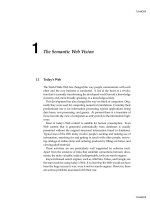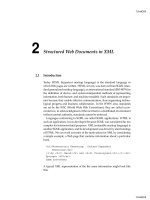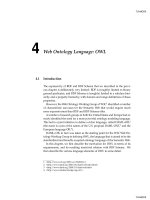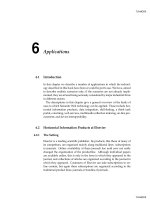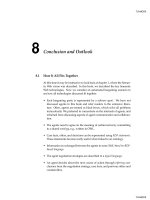MIT press a semantic web primer 2nd edition mar 2008 ISBN 0262012421 pdf
Bạn đang xem bản rút gọn của tài liệu. Xem và tải ngay bản đầy đủ của tài liệu tại đây (2.4 MB, 287 trang )
A Semantic Web Primer
Second Edition
Grigoris Antoniou and Frank van Harmelen
The development of the Semantic Web, with machine-readable content, has the potential to revolutionize the World Wide
Web and its uses. A Semantic Web Primer provides an introduction and guide to this still emerging field, describing its key
ideas, languages, and technologies. Suitable for use as a textbook or for self-study by professionals, it concentrates on
undergraduate-level fundamental concepts and techniques that will enable readers to proceed with building applications
on their own and includes exercises, project descriptions, and annotated references to relevant online materials.
A Semantic Web Primer provides a systematic treatment of the different languages (XML, RDF, OWL, and rules) and
technologies (explicit metadata, ontologies, and logic and inference) that are central to Semantic Web development as well as
such crucial related topics as ontology engineering and application scenarios. This substantially revised and updated second
edition reflects recent developments in the field, covering new application areas and tools. The new material includes a
properties; the SWRL language (in the chapter on rules); OWL-S (on which the discussion of Web services is now based).
The new final chapter considers the state of the art of the field today, captures ongoing discussions, and outlines the most
challenging issues facing the Semantic Web in the future. Supplementary materials, including slides, online versions of
many of the code fragments in the book, and links to further reading, can be found at .
Grigoris Antoniou is Professor at the Institute for Computer Science, FORTH (Foundation for Research and Technology–
Second Edition
discussion of such topics as SPARQL as the RDF query language; OWL DLP and its interesting practical and theoretical
A Semantic Web Primer
computer science / Internet
Hellas), Heraklion, Greece. Frank van Harmelen is Professor in the Department of Artificial Intelligence at the Vrije
“This book is essential reading for anyone who wishes to learn about the Semantic Web. By gathering the fundamental
topics into a single volume, it spares the novice from having to read a dozen dense technical specifications. I have used the
first edition in my Semantic Web course with much success.”
—Jeff Heflin, Associate Professor, Department of Computer Science and Engineering, Lehigh University
“This book provides a solid overview of the various core subjects that constitute the rapidly evolving Semantic Web discipline.
While keeping most of the core concepts as presented in the first edition, the second edition contains valuable language
updates, such as coverage of SPARQL, OWL DLP, SWRL, and OWL-S. The book truly provides a comprehensive view of the
Semantic Web discipline and has all the ingredients that will help an instructor in planning, designing, and delivering the
lectures for a graduate course on the subject.”
—Isabel Cruz, Department of Computer Science, University of Illinois, Chicago
Cambridge, Massachusetts 02142
978-0-262-01242-3
Antoniou and van Harmelen
Cooperative Information Systems series
Massachusetts Institute of Technology
A Semantic Web Primer
Grigoris Antoniou and Frank van Harmelen
Universiteit, Amsterdam, the Netherlands.
The MIT Press
Second Edition
A
Semantic
Web
Primer
Cooperative Information Systems
Michael P. Papazoglou, Joachim W. Schmidt, and John Mylopoulos, editors
Advances in Object-Oriented Data Modeling
Michael P. Papazoglou, Stefano Spaccapietra, and Zahir Tari, editors, 2000
Workflow Management: Models, Methods, and Systems
Wil van der Aalst and Kees Max van Hee, 2002
A Semantic Web Primer
Grigoris Antoniou and Frank van Harmelen, 2004
Aligning Modern Business Processes and Legacy Systems
Willem-Jan van den Heuvel, 2006
A Semantic Web Primer, second edition
Grigoris Antoniou and Frank van Harmelen, 2008
A
Semantic
Web
Primer
second edition
Grigoris Antoniou
and
Frank van Harmelen
The MIT Press
Cambridge, Massachusetts
London, England
© 2008 Massachusetts Institute of Technology
All rights reserved. No part of this book may be reproduced in any form by any
electronic or mechanical means (including photocopying, recording, or information
storage and retrieval) without permission in writing from the publisher.
This book was set in 10/13 Palatino by the authors using LATEX 2ε .
Printed and bound in the United States of America.
Library of Congress Cataloging-in-Publication Data
Antoniou, G. (Grigoris)
A semantic Web primer / Grigoris Antoniou and Frank van Harmelen. – 2nd ed.
p. cm. – (Cooperative information systems)
Includes bibliographical references and index.
ISBN 978-0-262-01242-3 (hardcover : alk. paper)
1. Semantic Web. I. Van Harmelen, Frank. II. Title.
TK5105.88815. A58 2008
025.04–dc22
2007020429
10
9
8
7
6
5
4
3
2
1
Dedicated to Konstantina
G.A.
Brief Contents
1 The Semantic Web Vision
1
2 Structured Web Documents: XML
25
3 Describing Web Resources: RDF
65
4 Web Ontology Language: OWL
113
5 Logic and Inference: Rules
157
6 Applications
185
7 Ontology Engineering
225
8 Conclusion and Outlook
245
A
Abstract OWL Syntax
253
vii
Contents
List of Figures
Series Foreword
Preface
1
xiii
xv
xix
The Semantic Web Vision
1
1.1 Today’s Web
1
1.2 From Today’s Web to the Semantic Web: Examples
1.3 Semantic Web Technologies
8
1.4 A Layered Approach
17
1.5 Book Overview
21
1.6 Summary
21
Suggested Reading
22
2
Structured Web Documents: XML
25
2.1 Introduction
25
2.2 The XML Language
29
2.3 Structuring
33
2.4 Namespaces
46
2.5 Addressing and Querying XML Documents
2.6 Processing
53
2.7 Summary
59
Suggested Reading
61
Exercises and Projects
62
ix
47
3
x
Contents
3
Describing Web Resources: RDF
65
3.1 Introduction
65
3.2 RDF: Basic Ideas
67
3.3 RDF: XML-Based Syntax
73
3.4 RDF Schema: Basic Ideas
84
3.5 RDF Schema: The Language
88
3.6 RDF and RDF Schema in RDF Schema
94
3.7 An Axiomatic Semantics for RDF and RDF Schema
3.8 A Direct Inference System for RDF and RDFS
102
3.9 Querying in SPARQL
103
3.10 Summary
109
Suggested Reading
109
Exercises and Projects
111
4
Web Ontology Language: OWL
97
113
4.1 Introduction
113
4.2 OWL and RDF/RDFS
114
4.3 Three Sublanguages of OWL
117
4.4 Description of the OWL Language
119
4.5 Layering of OWL
131
4.6 Examples
135
4.7 OWL in OWL
144
4.8 Future Extensions
150
4.9 Summary
152
Suggested Reading
152
Exercises and Projects
154
5
Logic and Inference: Rules
157
5.1 Introduction
157
5.2 Example of Monotonic Rules: Family Relationships
161
5.3 Monotonic Rules: Syntax
162
5.4 Monotonic Rules: Semantics
164
5.5 Description Logic Programs (DLP)
167
5.6 Semantic Web Rules Language (SWRL)
170
5.7 Nonmonotonic Rules: Motivation and Syntax
171
5.8 Example of Nonmonotonic Rules: Brokered Trade
173
5.9 Rule Markup Language (RuleML)
177
5.10 Summary
179
Suggested Reading
179
xi
Contents
Exercises and Projects
6
7
8
181
Applications
185
6.1 Introduction
185
6.2 Horizontal Information Products at Elsevier
185
6.3 Openacademia: Distributed Publication Management
6.4 Bibster: Data Exchange in a Peer-to-Peer System
195
6.5 Data Integration at Audi
197
6.6 Skill Finding at Swiss Life
201
6.7 Think Tank Portal at EnerSearch
203
6.8 e-Learning
207
6.9 Web Services
210
6.10 Other Scenarios
219
Suggested Reading
221
Ontology Engineering
225
7.1 Introduction
225
7.2 Constructing Ontologies Manually
225
7.3 Reusing Existing Ontologies
229
7.4 Semiautomatic Ontology Acquisition
231
7.5 Ontology Mapping
235
7.6 On-To-Knowledge Semantic Web Architecture
Suggested Reading
240
Project
240
Conclusion and Outlook
245
8.1 Introduction
245
8.2 Which Semantic Web?
245
8.3 Four Popular Fallacies
246
8.4 Current Status
248
8.5 Selected Key Research Challenges
Suggested Reading
252
A Abstract OWL Syntax
Index
261
253
251
237
189
List of Figures
1.1
1.2
1.3
1.4
A hierarchy
Intelligent personal agents
A layered approach to the Semantic Web
An alternative Semantic Web stack
11
16
19
20
2.1
2.2
2.3
2.4
2.5
2.6
Tree representation of an XML document
Tree representation of a library document
Tree representation of query 4
Tree representation of query 5
A template
XSLT as tree transformation
33
49
51
52
56
60
3.1
3.2
3.3
3.4
3.5
3.6
3.7
Graphic representation of a triple
A semantic net
Representation of a tertiary predicate
Representation of a tertiary predicate
A hierarchy of classes
RDF and RDFS layers
Class hierarchy for the motor vehicles example
69
70
72
82
86
88
93
4.1
4.2
4.3
4.4
4.5
4.6
Subclass relationships between OWL and RDF/RDFS
Inverse properties
relation of OWL DLP to other languages
Classes and subclasses of the African wildlife ontology
Branches are parts of trees
Classes and subclasses of the printer ontology
xiii
119
123
134
135
136
140
xiv
List of Figures
5.1
RuleML vocabulary
177
6.1
6.2
6.3
6.4
6.5
6.6
6.7
6.8
6.9
6.10
6.11
6.12
6.13
Querying across data sources at Elsevier
DOPE search and browse interface
AJAX-based query interface of openacademia
Interactive time-based visualization using the Timeline widget
Sample SeRQL query and its graphic representation
Bibster peer-to-peer bibliography finder
Semantic map of part of the EnerSearch Web site
Semantic distance between EnerSearch authors
Browsing ontologically organized papers in Spectacle
Work flow for finding the closest medical supplier
OWL-S service ontology
Profile to Process bridge
Web service domain ontology
187
189
192
192
195
198
206
206
207
211
212
215
218
7.1
Semantic Web knowledge management architecture
237
Series Foreword
The traditional view of information systems as tailor-made, cost-intensive
database applications is changing rapidly. The change is fueled partly by
a maturing software industry, which is making greater use of off-the-shelf
generic components and standard software solutions, and partly by the onslaught of the information revolution. In turn, this change has resulted in a
new set of demands for information services that are homogeneous in their
presentation and interaction patterns, open in their software architecture,
and global in their scope. The demands have come mostly from application domains such as e-commerce and banking, manufacturing (including
the software industry itself), training, education, and environmental management, to mention just a few.
Future information systems will have to support smooth interaction with
a large variety of independent multivendor data sources and legacy applications, running on heterogeneous platforms and distributed information networks. Metadata will play a crucial role in describing the contents of such
data sources and in facilitating their integration.
As well, a greater variety of community-oriented interaction patterns will
have to be supported by next-generation information systems. Such interactions may involve navigation, querying and retrieval, and will have to be
combined with personalized notification, annotation, and profiling mechanisms. Such interactions will also have to be intelligently interfaced with
application software, and will need to be dynamically integrated into customized and highly connected cooperative environments. Moreover, the
massive investments in information resources, by governments and businesses alike, call for specific measures that ensure security, privacy, and accuracy of their contents.
All these are challenges for the next generation of information systems. We
call such systems cooperative information systems, and they are the focus of this
series.
xv
xvi
Series Foreword
In lay terms, cooperative information systems are serving a diverse mix of
demands characterized by content—community—commerce. These demands
are originating in current trends for off-the-shelf software solutions, such as
enterprise resource planning and e-commerce systems.
A major challenge in building cooperative information systems is to develop technologies that permit continuous enhancement and evolution of
current massive investments in information resources and systems. Such
technologies must offer an appropriate infrastructure that supports not only
development but also evolution of software.
Early research results on cooperative information systems are becoming
the core technology for community-oriented information portals or gateways. An information gateway provides a “one-stop-shopping” place for
a wide range of information resources and services, thereby creating a loyal
user community.
The research advances that will lead to cooperative information systems
will not come from any single research area within the field of information
technology. Database and knowledge-based systems, distributed systems,
groupware, and graphical user interfaces have all matured as technologies.
While further enhancements for individual technologies are desirable, the
greatest leverage for technological advancement is expected to come from
their evolution into a seamless technology for building and managing cooperative information systems.
The MIT Press Cooperative Information Systems series will cover this area
through textbooks, and research editions intended for the researcher and the
professional who wishes to remain up-to-date on current developments and
future trends.
The series will include three types of books:
• Textbooks or resource books intended for upper-level undergraduate or
graduate level courses
• Research monographs, which collect and summarize research results and
development experiences over a number of years
• Edited volumes, including collections of papers on a particular topic
Data in a data source are useful because they model some part of the real
world, its subject matter (or application, or domain of discourse). The problem
of data semantics is establishing and maintaining the correspondence between
a data source, hereafter a model, and its intended subject matter. The model
may be a database storing data about employees in a company, a database
xvii
schema describing parts, projects, and suppliers, a Web site presenting information about a university, or a plain text file describing the battle of Waterloo. The problem has been with us since the development of the first
databases. However, the problem remained under control as long as the operational environment of a database remained closed and relatively stable.
In such a setting, the meaning of the data was factored out from the database
proper and entrusted to the small group of regular users and application
programs.
The advent of the Web has changed all that. Databases today are made
available, in some form, on the Web where users, application programs, and
uses are open-ended and ever changing. In such a setting, the semantics of
the data has to be made available along with the data. For human users, this
is done through an appropriate choice of presentation format. For application programs, however, this semantics has to be provided in a formal and
machine-processable form. Hence the call for the Semantic Web.1
Not surprisingly, this call by Tim Berners-Lee has received tremendous attention by researchers and practitioners alike. There is now an International
Semantic Web Conference series,2 a Semantic Web Journal published by Elsevier,3 as well as industrial committees that are looking at the first generation
of standards for the Semantic Web.
The current book constitutes a timely publication, given the fast-moving
nature of Semantic Web concepts, technologies, and standards. The book offers a gentle introduction to Semantic Web concepts, including XML, DTDs,
and XML schemas, RDF and RDFS, OWL, logic, and inference. Throughout,
the book includes examples and applications to illustrate the use of concepts.
We are pleased to include this book on the Semantic Web in the series on
Cooperative Information Systems. We hope that readers will find it interesting, insightful, and useful.
John Mylopoulos
Dept. of Computer Science
University of Toronto
Toronto, Ontario
Canada
Michael Papazoglou
INFOLAB
P.O. Box 90153
LE Tilburg
The Netherlands
1. Tim Berners-Lee and Mark Fischetti, Weaving the Web: The Original Design and Ultimate Destiny
of the World Wide Web by Its Inventor. San Francisco: HarperCollins, 1999.
2. <>.
3. <>.
Preface
The World Wide Web (WWW) has changed the way people communicate
with each other, how information is disseminated and retrieved, and how
business is conducted. The term Semantic Web comprises techniques that
promise to dramatically improve the current WWW and its use. This book is
about this emerging technology.
The success of each book should be judged against the authors’ aims. This
is an introductory textbook about the Semantic Web. Its main use will be to
serve as the basis for university courses about the Semantic Web. It can also
be used for self-study by anyone who wishes to learn about Semantic Web
technologies.
The question arises whether there is a need for a textbook, given that all
information is available online. We think there is a need because on the Web
there are too many sources of varying quality and too much information.
Some information is valid, some outdated, some wrong, and most sources
talk about obscure details. Anyone who is a newcomer and wishes to learn
something about the Semantic Web, or who wishes to set up a course on the
Semantic Web, is faced with these problems. This book is meant to help out.
A textbook must be selective in the topics it covers. Particularly in a field
as fast developing as this, a textbook should concentrate on fundamental
aspects that can reasonably be expected to remain relevant some time into
the future. But, of course, authors always have their personal bias.
Even for the topics covered, this book is not meant to be a reference work
that describes every small detail. Long books have already been written on
certain topics, such as XML. And there is no need for a reference work in
the Semantic Web area because all definitions and manuals are available online. Instead, we concentrate on the main ideas and techniques and provide
enough detail to enable readers to engage with the material constructively
and to build applications of their own.
That way readers will be equipped with sufficient knowledge to easily get
xix
xx
Preface
the remaining details from other sources. In fact, an annotated list of references is found at the end of each chapter.
Preface to the Second Edition
The reception of the first edition of this book showed that there was a real
need for a book with this profile. The book is in use in dozens of courses
worldwide and has been translated into Japanese, Spanish, Chinese and Korean.
The Semantic Web area has seen rapid development since the first publication of our book. New elements have appeared in the Semantic Web language stack, new application areas have emerged, and new tools are being
produced. This has prompted us to produce a second edition with a substantial number of updates and changes. In brief, this second edition has the
following new elements:
• All known bugs and errata have been fixed (notably the RDF chapter
(chapter 3) contained some embarrassing errors).
• The RDF chapter now discusses SPARQL as the RDF query language
(with SPARQL going for W3C recommendation in the near future, and
already receiving widespread implementation support).
• The OWL chapter (chapter 4) now discusses OWL DLP, a newly identified fragment of the language with a number of interesting practical and
theoretical properties.
• In the light of rapid developments in this area, the chapter on rules (chapter 5) has been revised and discusses the SWRL language as well as OWL
DLP.
• New example applications have been added to chapter 6.
• The discussion of web services in chapter 6 has been revised and is now
based on OWL-S.
• The final outlook chapter (chapter 8) has been entirely rewritten to reflect
the advancements in the state of the art, to capture a number of currently
ongoing discussions, and to list the most challenging issues facing the
Semantic Web.
xxi
We have also started to maintain a Web site with material to support the
use of this book: <>. The Web site contains slides for each chapter, to be used for teaching, online versions of code
fragments in the book, and links to material for further reading.
Acknowledgments
We thank Jeen Broekstra, Michel Klein, and Marta Sabou for pioneering
much of this material in our course on Web-based knowledge representation
at the Free University in Amsterdam; Annette ten Teije, Zharko Aleksovski
and Wouter Jansweijer for critically reading early versions of the manuscript;
and Lynda Hardman and Jacco van Ossenbruggen for spotting errors in the
RDF chapter.
We thank Christoph Grimmer and Peter Koenig for proofreading parts of
the book and assisting with the creation of the figures and with LaTeX processing.
For the second edition of this book, the following people generously contributed material: Jeen Broekstra wrote section 3.9 on SPARQL; Peter Mika
and Michel Klein wrote section 6.3 on their openacademia system; some of
the text on the Bibster system in section 6.4 was donated by Peter Haase from
his Ph.D. thesis; and some of the text on OWL-S was donated by Marta Sabou
from her Ph.D. thesis.
Also, we wish to thank the MIT Press people for their assistance with the final preparation of the manuscript, and Christopher Manning for his LATEX 2ε
macros.
1
1.1
The Semantic Web Vision
Today’s Web
The World Wide Web has changed the way people communicate with each
other and the way business is conducted. It lies at the heart of a revolution that is currently transforming the developed world toward a knowledge
economy and, more broadly speaking, to a knowledge society.
This development has also changed the way we think of computers. Originally they were used for computing numerical calculations. Currently their
predominant use is for information processing, typical applications being
database systems, text processing, and games. At present there is a transition of focus toward the view of computers as entry points to the information
highways.
Most of today’s Web content is suitable for human consumption. Even
Web content that is generated automatically from databases is usually
presented without the original structural information found in databases.
Typical uses of the Web today involve people’s seeking and making use of
information, searching for and getting in touch with other people, reviewing catalogs of online stores and ordering products by filling out forms, and
viewing adult material.
These activities are not particularly well supported by software tools.
Apart from the existence of links that establish connections between documents, the main valuable, indeed indispensable, tools are search engines.
Keyword-based search engines such as Yahoo and Google are the main
tools for using today’s Web. It is clear that the Web would not have become
the huge success it is, were it not for search engines. However, there are
serious problems associated with their use:
• High recall, low precision. Even if the main relevant pages are retrieved,
1
2
1
The Semantic Web Vision
they are of little use if another 28,758 mildly relevant or irrelevant documents are also retrieved. Too much can easily become as bad as too little.
• Low or no recall. Often it happens that we don’t get any relevant answer
for our request, or that important and relevant pages are not retrieved. Although low recall is a less frequent problem with current search engines,
it does occur.
• Results are highly sensitive to vocabulary. Often our initial keywords do
not get the results we want; in these cases the relevant documents use different terminology from the original query. This is unsatisfactory because
semantically similar queries should return similar results.
• Results are single Web pages. If we need information that is spread over
various documents, we must initiate several queries to collect the relevant
documents, and then we must manually extract the partial information
and put it together.
Interestingly, despite improvements in search engine technology, the difficulties remain essentially the same. It seems that the amount of Web content
outpaces technological progress.
But even if a search is successful, it is the person who must browse selected
documents to extract the information he is looking for. That is, there is not
much support for retrieving the information, a very time-consuming activity. Therefore, the term information retrieval, used in association with search
engines, is somewhat misleading; location finder might be a more appropriate term. Also, results of Web searches are not readily accessible by other
software tools; search engines are often isolated applications.
The main obstacle to providing better support to Web users is that, at
present, the meaning of Web content is not machine-accessible. Of course,
there are tools that can retrieve texts, split them into parts, check the spelling,
count their words. But when it comes to interpreting sentences and extracting
useful information for users, the capabilities of current software are still very
limited. It is simply difficult to distinguish the meaning of
I am a professor of computer science.
from
I am a professor of computer science, you may think. Well, . . .

